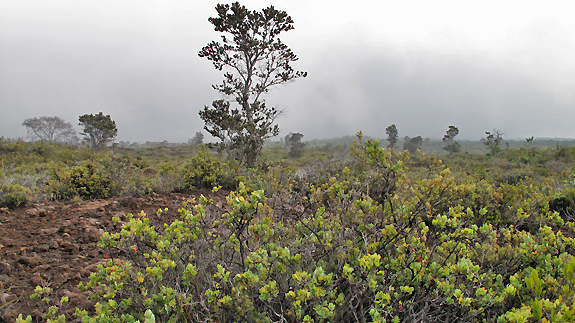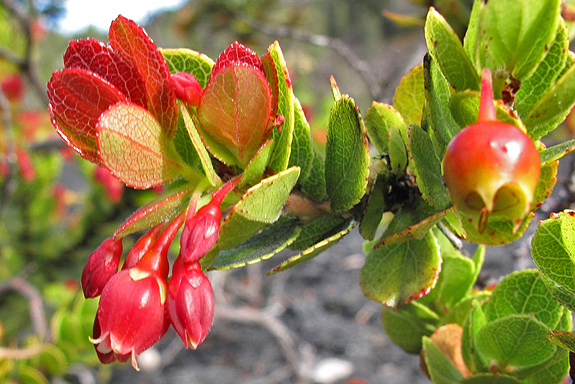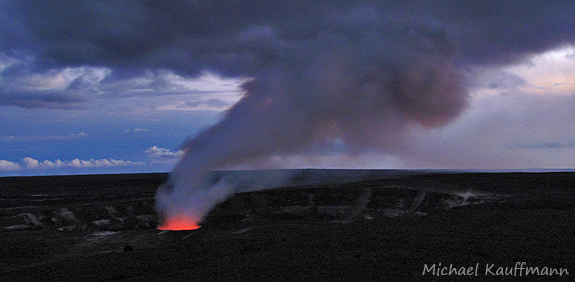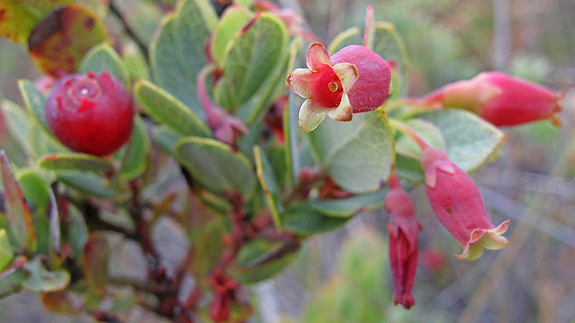Original Publication DATE: 12/25/2009
When John Sawyer and his wife Jane first invited Allison and I to join them on the Big Island for a few weeks, he issued a staunch warning when he said “Michael, there are no native conifers anywhere on the chain of Hawaiian Islands.” After some discussion with Allison I conceded that, even with the absence of conifers, this was an opportunity we could not miss. I was allowed to bring Farjon’s Conifers: A Natural History for some light reading on the beaches—otherwise we packed efficiently for the sub-tropics. John and Jane promised to bring all the plant books we could possibly need.
For the first few days plants were of secondary concern as we toured the beaches and snorkeled in underwater worlds I had never seen before. But eventually, we made our way into the high country, away from the beaches which were planted with, or invaded by, many non-native species. As we climbed the road to Mauna Kea, eventually into the alpine, we discussed plant distributions and origins on the islands as we peered far over the Pacific Ocean. Hawaii is one of the most isolated places on earth. The nearest land mass is another island chain called the Marquesas, which are 2,000 miles away, the west coast of North America is 2,400 miles, and Japan is 3,800 miles.
This volcanic chain of islands first started its fiery formation 80,000,000 years ago with the creation of Mejii, the western most island. Over time, at a rate of 3.5 inches per year, the plates shifted as lava continued to flow eventually establishing more than 80 islands spread over 3,800 miles. Mejii is now located—eroded and underwater—off the coast of Siberia’s Kamchatka Peninsula. The current western most island is Kure Atole which is 27 million years old and 1,600 miles from Honolulu (Walther). Kaua’i, the oldest of the eight main islands, is a mere 5 million years old. It is apparent, that on a grand scale, these islands form “fast” and die “fast.”
Having set the geological history straight, the big question for me became: How did the native plants get here? In the discussion that follows and in the research cited, native plants on Hawaii are described as pre-Polynesian plants—in other words, plants that have been here for tens of thousands of years that reached the islands without the aid of humans.

In 1961, Fosberg found that 18% of Hawaiin native plants were from the Americas, 17% form Australia, 40% from the Indio-Pacific, 3% from the arctic and the rest are of unknown origin. In 1970, Carlquist’s examined seed origin and found that, in those 80 million years, 270 species of plants eventually gave rise to 1,060 native species on the islands—that equates to one successful speciation event every 296,000 years! (Walter). Carlquist went on to state that of these 270 pioneers 1.4% arrived by air, 23.8% by sea and 74.8% by bird. So with the right vessel for distribution and a comfortable landing in just the right habitat, plant life evolved.
In our adventures around the Big Island Allison and I struggled to get comfortable with the plant families here—many of which were new to us. Over 60% percent of the plants here originated in the southern hemisphere, this was new botanical territory. We were definitely entertained by the newness, but it left us feeling like invasive species. We needed something to latch on to, to remind us of home—some sort of habitatual-home so-to-speak. As we climbed into the high country of Mauna Kea and Mauna Loa, particularly in the pristine native forests of Hawaii Volcanoes National Park, we recognized not only a family but a genus that we loved from the mainland.
Ericaceae is a common family for anyone who has enjoyed a blueberry pie, pondered a Manzanita in California, or slathered huckleberry jam on toast. As a general rule plants from the genus Vaccinium have tasty berries that people take advantage of, especially in the temperate regions of North America, every fall. Here on the Big Island of Hawaii, there are three native species of Vaccinium (Hall) and possibly up to six on the entire chain. These species hail originally from the north temperate regions and were distributed—by (constipated?) aerial adventurers—between Pacific Island mountain tops from Hawaii to Fiji to Somoa (Kepler). Merlin goes as far to say that these species closest relatives are located in the forests of the Pacific Northwest—giving more foundation to the comfort level we had when finding these plants. We felt at home in the high elevations forests and sub-alpine landscapes where the Vaccinium thrived.

As on the mainland, Vaccinium were held sacred by native Hawaiians. They believed that ‘ohelo, was venerated by the Volcano God, Pele. Before consuming the berries themselves, they would offer branches bearing fruits to Pele by throwing them into the fiery cauldron of Kilauea (Lamoureux). Allison and I offered our love to the island (because we were not allowed near Kilauea) and the experiences offered to us by its kind people before consuming (sparingly) the plentiful fruit on several of our hikes in Hawaii Volcanoes National Park. After a wonderful two week visit, our comfort for landscapes on the island grew as well. We reluctantly departed, back to the frigid winter of the mainland, excited to return another time to learn more about this sub-tropical wonderland.

Resources:
1. Carlquist, S. 1970, Hawaii: A Natural History, Natural History Press, New York, New York.
2. Fosberg, F.R. 1961. Guide to Excursions III, Tenth Pacific Congress. University of Hawaii at Manoa, Honolulu, Hawai’i.
3. Hall, John B. 2004. A Hiker’s Guide to Trailside Plants in Hawaii. Mutual Publishing, Honolulu, Hawaii.
4. Kelper, A.K., 1999, Hawaii’s Floral Splendor, Mutual Publishing, Honolulu, Hawaii.
5. Lamoureux, C.H. 1976. Trailside Plants of Hawaii National Park. Hawaii Natural History Association, Hawaii Volcanoes National Park.
6. Merlin, M.D. 1980. Hawaiian Forest Plants. Oriental Publishing Company, Honolulu, Hawaii.
7. Walther, Michael, 2004. A Guide to Hawaii’s Coastal Plants, Mutual Publishing, Honolulu, Hawaii.
—–
COMMENT:
AUTHOR: Kandler Smith
DATE: 12/25/2009 10:35:01 PM
My botanogeek wife and I enjoyed reading about your travels! Sounds like a great trip. Merry Christmas!
—–
COMMENT:
AUTHOR: David Fix
DATE: 12/26/2009 7:02:05 AM
Michael, thanks for the impressions. Jude and I also enjoyed veg in Kona, on Mauna Kea, and the south side of the Big Island last year. We did a tour with a guide named Garry who’s with Hawaii Forest & Trails. Didn’t know what to expect but it was really good, and we recommend him. While in the Hakalau NWR (protected and regenerated forest on ne. slope of Mauna Kea) we had an ohia lehua pointed out to us which was perhaps forty inches in diameter. Garry said that the ohia grow only millimeters per year (radially) at most after their youthful flush, and that this tree could have been a thousand years old. I stood there gazing at stout limbs where, quite likely, long-extinct birds such as the Hawaiian ‘O-‘O, Mamo, or Akialoa may have foraged. Spending minutes with this giant was the equivalent of seeing “the big Doug” on a nw. CA hike. As a birder, I listened to the songs of half a dozen native species–trills, whistles, and other semi-tropical utterances–and had to wonder what that forest chorus would have sounded like pre-Captain Cook+ with the extinct birds also chiming in.
// Speaking of big dougs, did you know there is a ~100″ dbh Douglas-fir along Hwy 101 in Del Norte Redwoods S.P. that is easily seen from the highway? Park at the entrance to Mill Creek CG and walk back south about a few hundred feet; the big boy stands west of the road about 75′ off it and is obvious. Aside from diameter it is not an especially heroic tree, but it’s the largest non-redwood I have seen in the park. Rave on. JOIN THE SPOTTED OWL PARTY. U.S. OUT OF NORTH AMERICA! NO FOR PRESIDENT IN 2012 / Fix
- David- Thanks for your impressions as well. I loved the birds up high as well and longed for more. Hakalau NWR sounds like a can’t miss next time we hit the island.

One Reply to “Hawai’i: Plant Evolution, Origin and the Genus Vaccinium (‘Ohelo)”
Comments are closed.